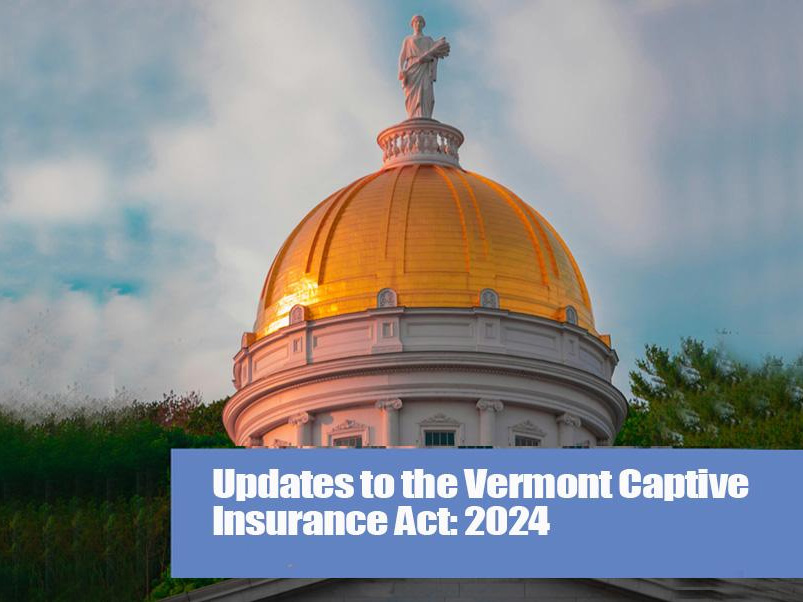
Primmer Named ‘Top Law Firm in NH’-2024

From Innovation to Protection: AI’s Influence on Confidentiality and Intellectual Property in the Workplace
On May 20, 2024, Vermont Governor Phil Scott signed into law Bill H.659 (the “Bill”), amending certain sections of the Vermont Captive Insurance Act, 8 V.S.A. § 6001 et seq. (the “Captive Act” or “Act”), to better reflect current industry practices and eliminate unnecessary redundancies. The amendments become effective July 1, 2024.
Among other housekeeping updates to the Captive Act, the Bill clarifies the scope of risks that may be insured by a sponsored captive insurance company. It also adds a new section to the sponsored captive insurance company subchapter of the Act to expressly authorize the conversion of a stand-alone captive insurance company into an unincorporated protected cell of a sponsored facility. Last, the Bill enhances and restructures the confidentiality provisions of the Act and revises the definition of parametric contract.
Sponsored Captive Insurance Companies
In an effort to clarify the scope of risks that may be insured by a sponsored captive insurance company, the legislature revised the definition of a sponsored captive. Prior to the passage of the Bill, the Captive Insurance Act’s definition of sponsored captive insurance company allowed for such companies to insure the risks of not only their participants but also other parties unaffiliated with a participant through separate participant contracts subject to approval of the Commissioner. See 8 V.S.A. § 6032(7). There were no explicit limitations or restrictions on the scope of unaffiliated risks that may be insured by a sponsored captive.
The Bill now amends the definition of sponsored captive to clarify that an “unaffiliated party” means a “controlled unaffiliated entity.”[1] “Controlled unaffiliated entity” means any person or entity that is not in the corporate system of a participant and its affiliated companies but that has an existing contractual relationship with a participant or one of its affiliated companies. Bill, at Section 1, Subsection 8. Such unaffiliated entity’s risk must also be managed by a participant in accordance with section 6019. Id. Section 6019 requires that a participant or its affiliated company is able to exercise control of the risk management function of any controlled unaffiliated business to be insured by a captive. 8 V.S.A. § 6019.
In essence, prior to the 2024 amendments, a sponsored captive could insure risks of unaffiliated parties so long as approved by the Commissioner. Now, any unaffiliated entity’s risk must be managed by the participant or affiliated companies and subject to a contractual relationship with such participant or its affiliated companies (i.e., a “controlled unaffiliated entity”).
In addition to amending the definition of sponsored captive insurance company, the Bill also includes a new provision regarding conversions of captives into unincorporated protected cells. Since the initial adoption of sponsored captive insurance legislation in 1999, the Captive Act has been consistently updated and refined as the use of cells and sponsored structures has evolved. The amendment to the sponsored captive subchapter to allow for conversions of stand-alone captives into unincorporated cells is yet another example of Vermont’s ability to adapt and respond to emerging industry practices.
The Captive Act currently allows for the conversion of protected cells into various forms of stand-alone captive insurance companies. See, e.g., 8. V.S.A. § 6034c. It does not, however, expressly authorize the conversion of a stand-alone captive into a protected cell. As a result of an increased interest in stand-alone captives to convert to a cell within a sponsored captive facility, the Captive Act has been updated to explicitly permit such a transaction. The Bill adds section 6034h to Subchapter 2. In relevant part, section 6034h(a)(1) states that, subject to the prior approval of the Vermont Commissioner, a stand-alone captive insurance company may be converted into an unincorporated protected cell.[2]
Similar to the Captive Act’s other conversion provisions, a conversion under section 6034h shall be deemed a continuation of the converted entity’s existence. Bill, at Section 2(b). Any conversion of an entity into a cell must be performed in accordance with applicable corporate statutes. Id. at (d)(1). In this way, the amendments to the sponsored captive subchapter also state that a protected cell that is not an incorporated protected cell shall be considered an “organization” as defined under the Vermont Limited Liability Company Act and Business Corporation Act for the purposes of a conversion. Id. at (d)(2). [3] The intent is to allow for a seamless transition of a captive into an unincorporated cell, as if it had always operated in that capacity.
Confidentiality Protections
In addition to the amendments to the sponsored captive subchapter, the Bill also seeks to strengthen and streamline the confidentiality provisions of the Captive Act. Prior to the passage of the Bill, there were redundant confidentiality provisions scattered throughout the Captive Act. The Captive Act previously contained two general sources of confidentiality protections: section 6002 (related to the licensing and authority of captive insurance companies) and section 6008 (related to examinations and investigations of captives by the Vermont Commissioner). In particular, section 6002(c)(3) provided confidentiality protections for information submitted as part of an application for licensure, including subsequent updates and amendments, except to the extent such information was requested in connection with a legal action in which the captive insurance company that submitted the information is party. Similarly, section 6008(c) provided that all examination reports and related documents produced during the course of an examination are confidential and protected from public disclosure.
In addition to these two general sources of confidentiality protections, other subchapters of the Captive Act related to special purpose financial insurance companies (“SPFI”) and affiliated reinsurance companies (“ARC”) contained the same provisions regarding the protection of information submitted to the Commissioner in the course of an examination. See 8 V.S.A. § 6048o; 8 V.S.A. § 6049m. Further, the subchapters regulating sponsored captive insurance companies and branch captive insurance companies both lacked any explicit confidentiality protections with respect to information submitted to the Commissioner during the course of an examination.
To improve and consolidate these provisions, the Bill first appears to reinforce the protections provided in section 6002(c)(3) by eliminating the required disclosure of confidential information submitted to the Vermont Department of Financial Regulation (DFR) pursuant to a subpoena in the event that such information is relevant and necessary to a legal action. See Bill, at Section 8 (eliminating subsections of 6002(c)(3) related to disclosure of confidentiality information in connection with legal action). Instead, the Bill grants the Commissioner discretion to disclose such information in the event that it is sought in furtherance of a legal action. See id. In addition, section 6008(c), which protects examination reports and other related materials from disclosure, has been updated to eliminate repetitive language and instead now directly incorporates the protections of section 6002(c)(3) regarding the disclosure of confidential information. See Bill, at Section 9 (incorporating reference to section 6002 with respect to the Commissioner’s discretion to disclose certain information).
Similarly, the provisions of the SPFI and ARC subchapters protecting information submitted as part of an examination to the Commissioner have been amended to eliminate redundant language. See Bill, at Sections 10 and 11. Both subchapters now directly incorporate the protections of the sections 6002(c)(3) and 6008(c). Id. These same confidentiality protections have also been added to the sponsored captive and branch captive subchapters. See Bill, at Sections 13 and 14. In short, the Bill has included confidentially protections where there were otherwise gaps in protection while also consolidating certain provisions to create a more clear and concise statute.
Although technically not part of the Captive Act, the chapter of the Insurance Code regulating risk retention groups has similarly been updated to include the same language as the Captive Act regarding protections for information submitted to the Vermont Commissioner in connection with an application for licensure. See Bill, at Section 16. The purpose for the update is to maintain consistency between the risk retention group and captive insurance chapters of the Insurance Code, as both forms of insurance are regulated by the Captive Division of DFR
Relatedly, the Bill simplifies the provisions in the Captive Act permitting the Commissioner to share and receive documents and materials, including those that may be confidential and privileged, with other state, federal, and international regulatory agencies and authorities, including the National Association of Insurance Commissioners (NAIC). Prior to the Bill, the confidentially protections of the subchapters discussed above each contained provisions authorizing the sharing of such information by the Commissioner. For efficiency purposes, the Bill updates 8 V.S.A. § 22 regarding information sharing agreements to apply more broadly to captive insurance companies. The confidentiality provisions of the Captive Act, in turn, have been amended to eliminate superfluous language and instead expressly incorporate section 22.
Parametric Contracts
The Captive Act has also been updated to eliminate overly prohibitive language regarding parametric contracts. Last year, the Act was amended to specifically allow captive insurance companies to transfer risk by means of parametric contract. That provision also contained language that stated that a parametric contract is categorically not an insurance contract. Since that time, companies have increasingly turned to parametric contracts as an alternative solution to manage certain risks, notably those related to natural disasters, such as wind events. Parametric contracts are being structured to address these risks in such a way so as to constitute insurance contracts under state laws. Rather than be overly prescriptive, the Vermont legislature has deferred to the expertise of DFR to determine whether a parametric contract should be considered insurance and how best to regulate their use by captives. As a result, the Bill eliminates the definition of parametric contract from section 6002 of the Captive Act and instead simply permits a captive to transfer risk by such means so long as it does so in compliance with all state and federal laws and regulations.
Vermont is consistently recognized as the “Gold Standard” in the captive insurance industry. This is due in large part to its strong captive insurance laws, which are reviewed and updated annually through a collaborative process among industry interests, state legislators and regulators, and legal experts. The result is a robust and efficient Captive Insurance Act that remains in line with current industry practices. Ultimately, the 2024 updates to the Captive Act demonstrate the State’s commitment to the success of the captive industry in Vermont, and may also serve as a model for other states looking to keep pace with the captive market.
[1] Section 1 of the Bill states that a sponsored captive may only insure the “risks of its participants or, subject to Commissioner approval, other parties unaffiliated with a participant as defined in subsection 6036(d) of this title, through separate participant contracts.” (emphasis added). Section 6036(d) in turn says that a “participant shall not insure any risks other than its own and the risks of affiliated entities or of controlled unaffiliated entities.” Subsection 8 of Section 1 of the Bill defines “controlled unaffiliated entity” as any person or entity: “(A) that is not in the corporate system of a participant and its affiliated companies; (B) that has an existing contractual relationship with a participant or one of its affiliated companies; and (C) whose risks are managed by a participant, as applicable, in accordance with section 6019 of this title.” Although it takes a few steps, reading these provisions together establishes that a sponsored captive insurance company may not insure the risks of unaffiliated entities unless such an entity has a contractual relationship with a participant and its risk are managed by such participant.
[2] As proposed by Section 2 of the Bill, section 6304h(a)(1) specifically authorizes the conversion of “an agency captive insurance company, association captive insurance company, industrial insured captive insurance company, pure captive insurance company, risk retention group, or special purpose financial insurance company” into an unincorporated protected cell.
[3] Both the Business Corporation and Limited Liability Company Act define “organization” in the context of a conversion as any of the following: (i) a business corporation; (ii) a nonprofit corporation; (iii) a general partnership, including a limited liability partnership; (iv) a limited partnership, including a limited liability limited partnership; (v) a limited liability company; (vi) a general cooperative association; (vii) a limited cooperative association or mutual benefit enterprise; (viii) an unincorporated nonprofit association; (ix) a statutory trust, business trust, or common-law business trust; or (x) any other person that has: (I) a legal existence separate from any interest holder of that person; or (II) the power to acquire an interest in real property in its own name.




